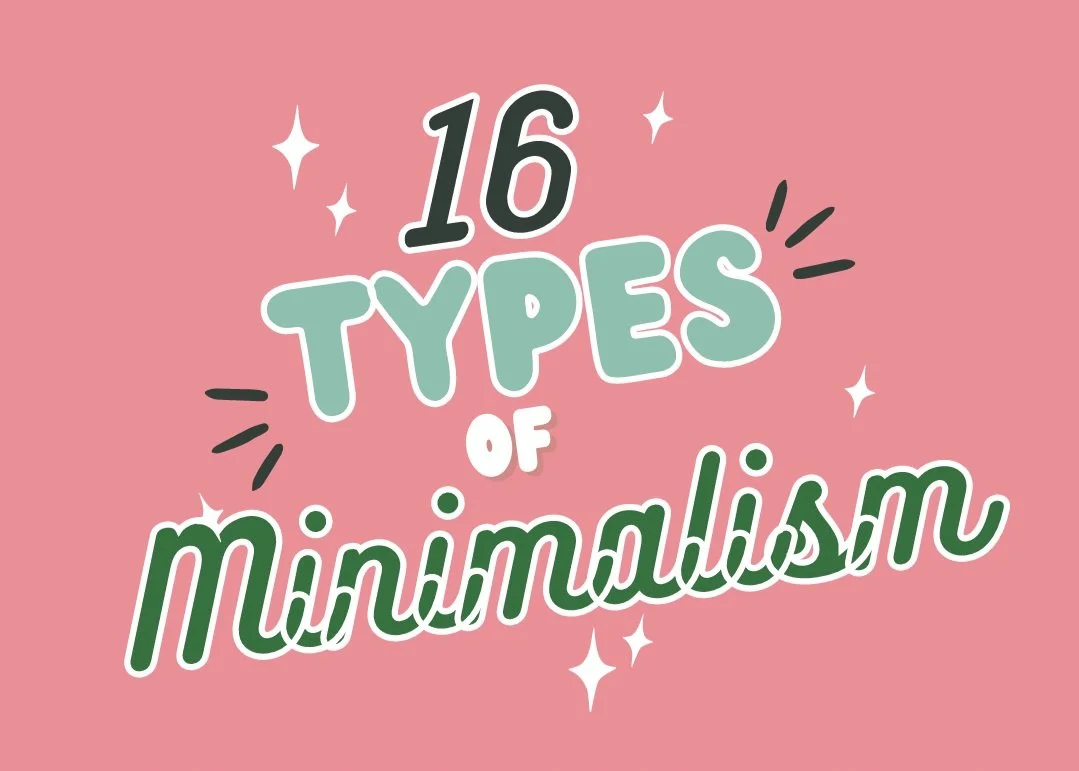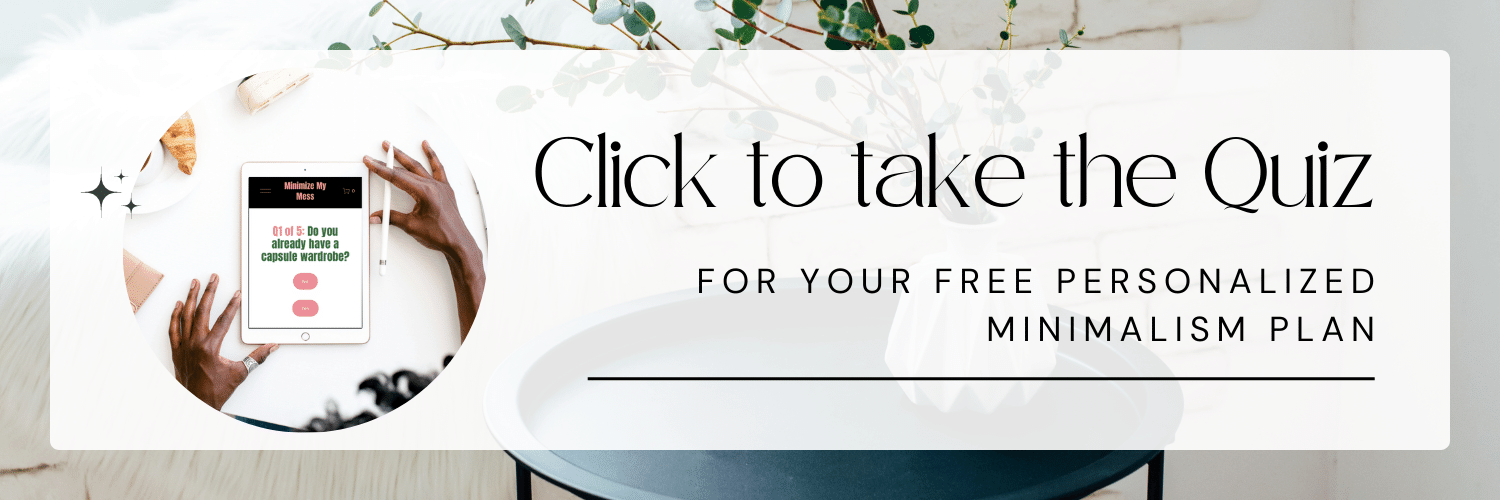16 Different Types of Minimalism (Which one is right for you?)
Not all minimalism is the same (thank goodness, where would the fun be in that)
The trick is to find the right flavour of minimalism for you.
Personally, I’m a bit of an eco-leaning-thrifty-souled-loosey-goosey-messy-minimalist
…how about you?
Check out this list of different types of minimalism, then let me know in the comments below.
1) Holier-than-thou minimalism
My absolute least favourite type of minimalism, is any minimalism that makes people think they have a right to judge others.
Everyone’s minimalism looks different, and we have to respect - nay, celebrate that!
You can often spot holier-than-thou minimalists hanging out in Facebook groups, making comments starting with “you should…”, or dictating how many things to own.
I’ve said it before - there are no minimalism police, and I stand by it, but holier-than-thou minimalists are definitely the self appointed minimalism neighbourhood watch
Ignore them.
Unfollow them.
You’re the boss, no one has any right to tell you how your home and life “should” run.
Here’s a fun mini rant:
2) Pinterest-perfect minimalism
AKA throw everything out and buy everything new.
This is my second least favourite type of minimalism, because so many of us feel pressured to be a “perfect” minimalist, right from day 1.
Instead of easing in to minimalism organically, and taking the time to discover how it will fit in with our lives, we can rush in and miss a lot of the real benefits.
Here are some ways Pinterest-perfect minimalism can show up:
Throwing out every item in our wardrobe because it’s fast fashion and replacing it with clothes from trendy ethical brands …which is actually much less sustainable than wearing our existing pieces until they need to be replaced
Instantly replacing all of our furniture with super chic, “minimalist” pieces …which doesn’t give us the chance to gently work through our impulse buying tendencies (a surprisingly emotional process for some of us)
Buying fancy “minimalist” decor to fit in with #minimalist on Instagram …which doesn’t teach us how to let go of keeping up with the Jones’
There’s no deadline to meet and no one else to beat.
Give yourself permission to take things slowly, and you may just be surprised about where your minimalism takes you (ours took us to a 630sqft 1 bed apartment with a solid retirement plan)
3) Design minimalism
Design minimalism is what I used to think minimalism was.
Imagine a phycologist’s house in any thriller movie. You know - floor to ceiling windows, concrete floors, pure white walls, a solitary monstera deliciosa plant, and a fancy industrial coffee machine.
I was really confused about how anyone but super rich people could be minimalists.
Nowadays I’m more of the mindset that minimalism is how your home functions and feels, not about how it looks.
But for some people the minimalist aesthetic is really important and brings them a lot of peace and I love that for them.
4) Eco-friendly minimalism
Avoiding excess and waste naturally lends itself to becoming more green.
I’ve always wanted to be more eco-friendly, so I love that minimalism has made that a bigger part of my life.
Our favourite eco-conscious minimalism benefits:
Downsized to a smaller home
Reduced our commute
No second car
Buy less
Waste less
Reuse and repurpose more
Buy secondhand, first
More conscious about what we buy and who we buy from when we do buy new
5) Thrifty minimalism
Reducing impulse buys and cutting down on unnecessary spending naturally lends itself to being thrifty.
We’ve both always been bad with money so saving money with minimalism was a surprising and life-changing side effect.
Our favourite thrifty benefits of minimalism:
Got of out debt years
Made a retirement plan
We do a monthly no spend week
We cancelled Amazon Prime and drastically reduced our online shopping habit
Completely changed how, when and how often we buy things
We have rainy day savings
More time and energy to learn about investing
We are able to support our favourite organizations more often:
More time and energy to create this blog (which is starting to make money)
6) Unchosen minimalism
I think a lot of us in the minimalism space sometimes forget that choosing a minimalist lifestyle is a huge privilege.
Many of us live through seasons of not being able to afford the things we need, let alone all the things we want.
Even if that season comes to an end, it can have a knock-on effect on our relationship with our stuff.
It’s not uncommon for people that have gone without to develop a scarcity mindset and really struggle with decluttering and letting go of belongings.
Chosen Minimalism
Unchosen Minimalism
A conscious decision
Having less is a success
Letting go of items is less scary because you can likely replace them
Having less saves time, money and energy, and brings you more peace
Not a conscious decision
Having less is stressful
Letting go of items is scary because you likely can’t replace them easily
Having less still saves time, money and energy, but brings you more stress
For my first couple of years in Canada everything I owned could fit into my backpack, I rented furnished rooms and I mastered the art of making gourmet ramen noodles.
I gratefully received hand me downs from friends for my first few years, and I continued to accumulate extra stuff for a long time after I needed to, because it made me feel more secure.
7) Medical minimalism
Another layer of unchosen minimalism can be people with health conditions that force them to live with less.
Some are mentally and/or physically unable to manage an “average” household, so minimalism can be a survival tactic to save on spoons.
8) Beginner minimalism
If you’ve done my free challenge (how to become a minimalist in 30 days), you know that you’re officially a minimalist the second that you decide to be.
For me, minimalism is an ongoing process.
We live in a very small space nowadays, so our home may never look traditionally minimalist, and that’s ok - it’s functional, easily tidied, and calmish.
But there was a long time in our previous home, where I wanted an easier and simpler life, and I knew that owning less was the answer …but our spare room was still waist deep in clutter.
I would classify this stage as beginner minimalism - I knew that I wanted to minimize, but I wasn’t quite sure how to get there and my home still felt very chaotic.
This can be a really frustrating stage of minimalism, as it takes some time to start seeing the benefits.
Different approaches work for different people - I cover lots of different ways to get started with decluttering when overwhelmed.
You got this! Things get easier and the benefits of minimalism will start to snowball, I promise :)
9) Freedom minimalism
Owning less, needing less and spending less can open up new ways of living that you may have never even imagined.
Freedom minimalists prioritize traveling and experiences over material possessions and traditional lifestyles.
Imagine being able to pack a back and head off on a new adventure at a moment’s notice.
Work/location freedom means you could live/work from anywhere!
10) Slow living minimalism
Slow living minimalism is all about unsubscribing from the rat race and going your own way.
I find it really beautiful because it focuses more on maximizing time and energy, rather than minimizing clutter:
Unplug
Find mindful moments throughout your day
Savour the little things
Minimize your schedule
Meaningful interactions
Simplify your routine
Quality time in nature
Meditate
Be intentional with screen time
Eat local, whole foods
Stop wearing busy as a badge of honour
Turn off notifications
Find your flow
11) Extreme minimalism
Extreme minimalism reminds me of living in a hotel - simply living with the bare essentials.
I follow some people who know the exact number of items they own.
It used to baffle me but now I find myself craving the freedom of having less and less.
I don’t think Sean will ever want to be an extreme minimalist, but I personally don’t feel like I’ve reached my “peak” minimalism levels yet.
12) Messy minimalism
This is minimalism for people that have more important things to do than wear matching socks.
This type of minimalism is very similar to realistic minimalism (see no.13), but it’s especially for messy people.
I’ve always been messy & lazy, and always thought there was something wrong with me (I was wrong).
So owning less is like a soothing balm to my messiness, here’s how:
I love that I can have a “shit box” (aka dump drawer or doom box) for things that I just can’t be arsed to put away right now
I love that I can just throw clothes in to the wardrobe, I don’t need to fold them
I love that we can tidy any room in 5 minutes
I love that I can not only accept my messiness, but laugh about it too
I love that it encourages us to store things where we actually use them and not where they’re “supposed” to be (e.g. Sean gets up for work before everyone else and our wardrobe is in our daughter’s room (the only bedroom), so he keeps his work clothes in the bathroom and gets dressed in there)
I love that Willow can be a messy toddler without stressing me out, because we rotate her toys so there’s only a few out at once. Yeah baby, you go ahead and throw all of your toys on the floor - no biggie, we can both tidy it up in less than a minute.
I love that I don’t stress about things looking perfect all the time, or last minute guests.
13) Realistic minimalism
Real life minimalism is the minimalism of the people.
It’s as unique as you are - just take a balanced approach and minimize however much you need to make your life easier.
If you love it - keep it, if you use it - keep it, if you don’t - don’t.
14) Semi minimalism
I love the idea of semi-minimalism.
Some semi-minimalists collect plants, some semi-minimalists collect books.
I think of it as Monica from Friends, who was super organized but had a secret cupboard jam packed full of clutter, lol.
If it works for you, it works for you! You don’t have to feel guilty about not being a “perfect” minimalist.
A lady I know has a lovely minimalist home and lifestyle, apart from her collection of 250+ shoes.
And you know what, she’s happy as a clam so power to her.
Minimalism doesn’t have to take over every area of your life.
15) Intentional minimalism
Being intentional is at the root of every type of minimalism.
I see intentional minimalism as a combination of all of the positive aspects of the types of minimalism that we’ve discussed - freeing up our time, money and energy to live a full and intentional life.
16) At peace minimalism
This is the kind of zen, minimalism level up that I aspire to.
No more tying my worth to things, my meat suit, or what other people think.
Just acceptance, peace, contentment and joy.
Conclusion
Of course, every type of minimalism overlaps with others so we’ll probably never fit neatly in to one little box.
But it’s interesting to look at some of these different kinds of minimalism to remind ourselves what we want to focus on.
At the end of the day, the best type of minimalism is whatever works for you and your family.
Let me know what types of minimalism speak to your the most in the comments below :)


